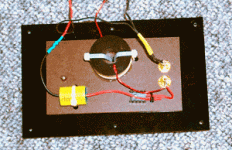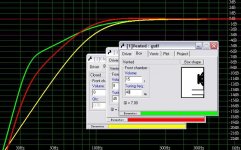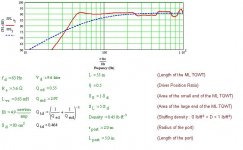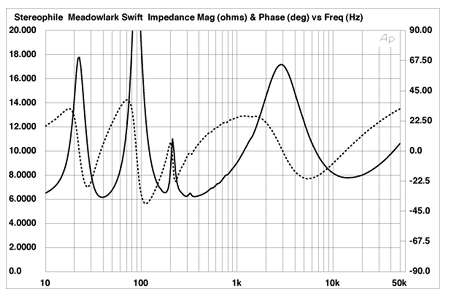Id like to build a few Swift clones using the Madisound Swifty kit (drivers same as the original apparently).
The kit uses a 2nd order on the woofer and 3rd+ on the tweeter I believe. I would rather use a 1st order like the original but
havent a clue as to what they did. The manufacturer says: "One heatsinked Caddock resistor, one Auricap capacitor and one heavy gauge Sidewinder air core inductor". The specs for the drivers are below. Any good guesses? Series maybe? And why a heatsink
on the resistor?
http://www.tymphany.com/datasheet/printview.php?id=218
http://www.tymphany.com/datasheet/printview.php?id=230
amt
The kit uses a 2nd order on the woofer and 3rd+ on the tweeter I believe. I would rather use a 1st order like the original but
havent a clue as to what they did. The manufacturer says: "One heatsinked Caddock resistor, one Auricap capacitor and one heavy gauge Sidewinder air core inductor". The specs for the drivers are below. Any good guesses? Series maybe? And why a heatsink
on the resistor?
http://www.tymphany.com/datasheet/printview.php?id=218
http://www.tymphany.com/datasheet/printview.php?id=230
amt
amt said:I would rather use a 1st order like the original
Why? The original was a failure, and a great example of how terrible design can kill a company. Two components is not enough to control the response curves of those speakers. I see things like that and wonder how some "high end" speakers companies even make it. Well, most don't actually.
Use Madisound's crossover. It's leaps and bounds better because they actually measured the speakers and modeled the crossover.
Why? Well mainly due to its apparent simplicity and supposed good performance. Ive not heard a pair but I was unable to find any less-than-positive reviews by either the big publications or various forum contributors. What were the negative traits that the xo contributed?
Ive always liked the aesthetics of their offerings since they were not cookie cutter columns and showed some craftsmenship. I like the unconventional look and since the drivers are available cheaply...
Is a parallel or series 1st order just deemed low performance these days or is it more the driver selection than the network?
And I was unaware that inept engineering was what killed the company off. They seemed to have a fairly large following and a good value.
amt
Ive always liked the aesthetics of their offerings since they were not cookie cutter columns and showed some craftsmenship. I like the unconventional look and since the drivers are available cheaply...
Is a parallel or series 1st order just deemed low performance these days or is it more the driver selection than the network?
And I was unaware that inept engineering was what killed the company off. They seemed to have a fairly large following and a good value.
amt
If you are going to try getting some meaningful info out of a review in a periodical, you have to realize there are no bad reviews. Reading between the lines is a must. A "great" speaker might only be marginally acceptable, while a "good" speaker is probably horrible. But if you can, forget all the subjective verbage and look at a measurement for some truth.
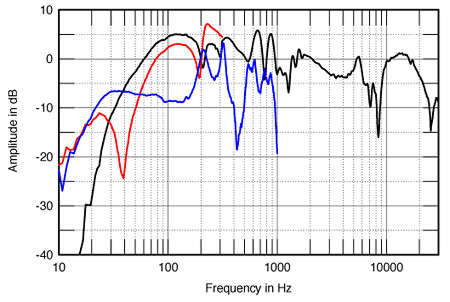
The large dip at 8khz is a failure of the single inductor to properly control the woofer's breakup node, which happens to be out of phase on the listening axis. Move 2" and it turns into a huge peak. The peak and dip below that are a failure to get proper phase tracking between drivers, combined with the tweeter's high Qts low end peak not being tamed by a single cap. The junk below 1khz is likely just poor cabinet damping.
Single component crossovers, with rare exception, usually result in a poor design. Of the many speaker designs I've done over the years, only one actually worked well with a single component per driver, and that was under unusual design conditions.

The large dip at 8khz is a failure of the single inductor to properly control the woofer's breakup node, which happens to be out of phase on the listening axis. Move 2" and it turns into a huge peak. The peak and dip below that are a failure to get proper phase tracking between drivers, combined with the tweeter's high Qts low end peak not being tamed by a single cap. The junk below 1khz is likely just poor cabinet damping.
Single component crossovers, with rare exception, usually result in a poor design. Of the many speaker designs I've done over the years, only one actually worked well with a single component per driver, and that was under unusual design conditions.
Hi,
if you wanted a c/o detective seems you got one of the best .......
Just read the stereophile review of said louspeaker .......
And madisounds PDF for the Swifty .......
TBH I agree with everything said by Zaph, the original is a poor
design, the test results do not show the vertical variations, which
as described are extremely poor, probably a political decision.
for a driver with Vas ~ 10L a box a lot bigger than 10L is becoming a waste.
For a floorstanding speaker similar to the original :
Use the madisound crossover as stated.
Any angling of the baffle should reflect lower than normal height,
i.e. mid/ tweeter axis should be pointed to ear at listening position.
I've included some sims, depth is going to be restricted, so line
the cabinet - i'd recommend significant depth on the back and
one sidewall, add stuffing to the top half. Put the port on the
back ~ 1/4 to of the way up.
If you want the port on the bottom I'd suggest asking for some
MJK type sims of whats going on - its a sort of ML(T)QWT.
These sims may suggest a larger box and different vent size.
They may suggest a TL could be a better option.
Of which there are plenty of variations.
 /sreten.
/sreten.
if you wanted a c/o detective seems you got one of the best .......
Just read the stereophile review of said louspeaker .......
And madisounds PDF for the Swifty .......
TBH I agree with everything said by Zaph, the original is a poor
design, the test results do not show the vertical variations, which
as described are extremely poor, probably a political decision.
for a driver with Vas ~ 10L a box a lot bigger than 10L is becoming a waste.
For a floorstanding speaker similar to the original :
Use the madisound crossover as stated.
Any angling of the baffle should reflect lower than normal height,
i.e. mid/ tweeter axis should be pointed to ear at listening position.
I've included some sims, depth is going to be restricted, so line
the cabinet - i'd recommend significant depth on the back and
one sidewall, add stuffing to the top half. Put the port on the
back ~ 1/4 to of the way up.
If you want the port on the bottom I'd suggest asking for some
MJK type sims of whats going on - its a sort of ML(T)QWT.
These sims may suggest a larger box and different vent size.
They may suggest a TL could be a better option.
Of which there are plenty of variations.
Attachments
You're right! After perusing Zaphs website, it seems I did get a Poirot.
Thanks Zaph, I will go with the Madisound xo but I may just try the 1st order too since I can round up the parts for a trial. Since I will probably build at least 4, side-by-side comparison may be interesting just to hear what the graphs show. What might be a reasonable xo point?
The port will probably be downfiring and I will definately keep the time-alignment angle and listening height in mind. This will be doing mostly HT/bedroom/office duty so adjustable feet may be in order.
I put the numbers into MJKs program and came up with a fairly good response which will produce a similar sized cabinet.
amt
Thanks Zaph, I will go with the Madisound xo but I may just try the 1st order too since I can round up the parts for a trial. Since I will probably build at least 4, side-by-side comparison may be interesting just to hear what the graphs show. What might be a reasonable xo point?
The port will probably be downfiring and I will definately keep the time-alignment angle and listening height in mind. This will be doing mostly HT/bedroom/office duty so adjustable feet may be in order.
I put the numbers into MJKs program and came up with a fairly good response which will produce a similar sized cabinet.
amt
Attachments
Well it looks like that spike at 2800hz must be the xo point. Looks like the average impedance is above 8ohms, provided Im reading this correctly. It would seem that using Re to pick the components would result in a higher, rather than lower xo point if the average impedance is higher. But two programs Ive used require ask for the nominal rather than Re. I would think that with a 1st order, getting closer to the Fs of the tweeter is a bad thing and moving the other direction is preferable.
amt
amt
- Status
- This old topic is closed. If you want to reopen this topic, contact a moderator using the "Report Post" button.
- Home
- Loudspeakers
- Multi-Way
- crossover detective needed for the Swift
